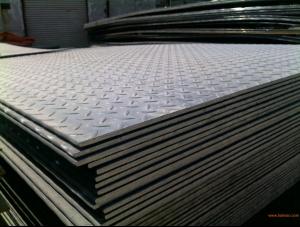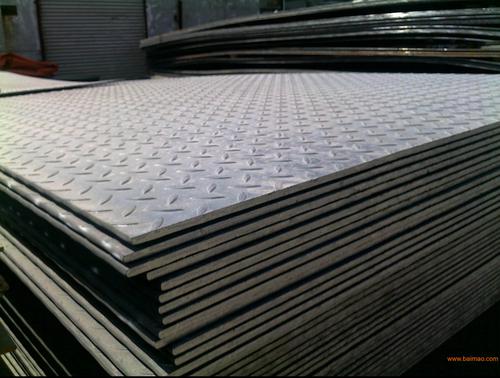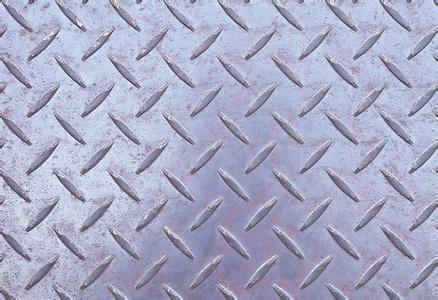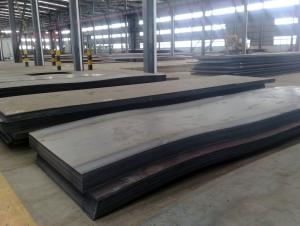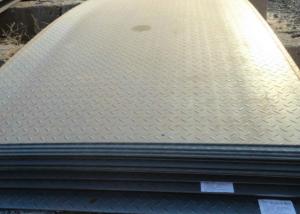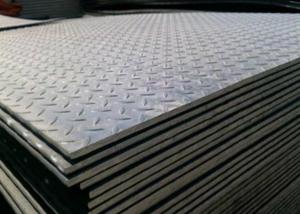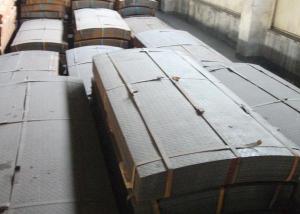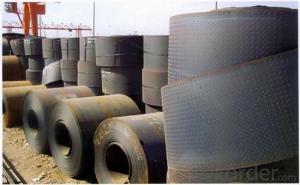Hot rolld checkered plate
- Loading Port:
- China Main Port
- Payment Terms:
- TT OR LC
- Min Order Qty:
- -
- Supply Capability:
- -
OKorder Service Pledge
OKorder Financial Service
You Might Also Like
A tread surface plate is called a pattern plate, English Name: Diamond plate.The pattern of lentil shaped, diamond, round bean shaped, oval hybrid shape,the market to the most common lentil shaped. Pattern plate appearance, canslip, enhanced performance, and many other advantages, such as saving steel in transportation, construction, decoration, equipment around the floor,machinery, shipbuilding and other fields has been widely applied. In general,the use of side of the mechanics pattern plate performance, mechanical performance requirements is not high, so the pattern plate quality mainlyflowering rate, as the pattern of height, the pattern height. At present thecommon thickness on the market ranging from 2.0-8mm, the width of common 12501500mm two. In accordance with the provisions of national standardsGB/T 3277 pattern plate, pattern height should be greater than or equal to the thickness of the 20% substrate. Pattern plate, according to the material(aluminum alloy, stainless steel, ordinary steel etc.) different patterns of different shapes and different weight per square meter adjustment
The following is a common pattern plate theory weight table:
Checkered plate theory weight table (mm)
花纹钢板理论重量表(mm) | ||||
基本厚度 | 基本厚度允许偏差 | 理论质量(kg/m²) | ||
菱形 | 扁豆 | 圆豆 | ||
2.5 | ±0.3 | 21.6 | 21.3 | 21.1 |
3.O | ±O.3 | 25.6 | 24.4 | 24.3 |
3.5 | 土0.3 | 29.5 | 28.4 | 28.3 |
4.O | ±O.4 | 33.4 | 32.4 | 32.3 |
4.5 | ±O.4 | 38.6 | 38.3 | 36.2 |
5.O | +O.4 | 42.3 | 40.5 | 40.2 |
-O.5 | ||||
5.5 | +O.4 | 46.2 | 44.3 | 44.1 |
-O.5 | ||||
6 | +O.5 | 50.1 | 48.4 | 48.1 |
-O.6 | ||||
7 | 0.6 | 59 | 58 | 52.4 |
-O.7 | ||||
8 | +O.6 | 66.8 | 65.8 | 56.2 |
-O.8 | ||||
| | ||||
- Q: Are steel sheets suitable for high-vibration environments?
- Yes, steel sheets are suitable for high-vibration environments. Steel is a strong and durable material that can withstand vibrations without experiencing significant deformation or damage. It is commonly used in industries such as construction, automotive, and aerospace, where high-vibration environments are common. Additionally, steel sheets can be designed and manufactured to have vibration-damping properties, further enhancing their suitability for such environments.
- Q: What is the difference between a painted and powder coated steel sheet?
- The main difference between a painted and powder coated steel sheet lies in the application process. Painted steel sheets involve applying liquid paint onto the surface, which can result in a thinner and less durable coating. On the other hand, powder coated steel sheets involve electrostatically applying dry powder onto the surface, followed by curing in an oven, resulting in a thicker and more durable coating. Powder coating also offers better resistance to chipping, scratching, and fading compared to traditional paint.
- Q: Are steel sheets suitable for railway track construction?
- Yes, steel sheets are suitable for railway track construction. Steel sheets are commonly used in the construction of railway tracks due to their high strength, durability, and resistance to wear and tear. They provide stability to the tracks, allowing trains to operate smoothly and efficiently. Additionally, steel sheets are capable of withstanding heavy loads and extreme weather conditions, making them an ideal choice for railway track construction.
- Q: How do steel sheets perform in corrosive environments?
- Steel sheets perform well in corrosive environments due to their inherent resistance to rust and oxidation. The presence of chromium and other alloying elements in steel forms a protective layer, known as the oxide layer, which prevents corrosion and extends the lifespan of the steel sheets. Additionally, coatings such as galvanization or painting can further enhance their resistance to corrosion, making steel sheets a reliable choice for applications in corrosive environments.
- Q: What are the different alloying elements used in steel sheets?
- There are several alloying elements used in steel sheets to enhance their properties and performance. Some of the commonly used alloying elements include: 1. Carbon: The most important alloying element in steel, carbon provides strength and hardness to the material. It also improves the steel's ability to be heat-treated, making it suitable for various applications. 2. Manganese: Manganese is commonly added to steel sheets to improve their mechanical properties, such as strength and toughness. It also helps in reducing the brittleness of the steel. 3. Chromium: Chromium is added to steel sheets to enhance their corrosion resistance. It forms a thin protective layer on the surface of the steel, preventing it from rusting or corroding easily. 4. Nickel: Nickel is often used in steel sheets to improve their toughness and resistance to impact. It also enhances the steel's ability to withstand extreme temperatures, making it suitable for high-temperature applications. 5. Silicon: Silicon is commonly added to steel sheets to improve their strength and hardness. It also helps in deoxidizing the steel during the manufacturing process. 6. Vanadium: Vanadium is used as an alloying element in steel sheets to improve their strength, toughness, and heat resistance. It also helps in refining the grain structure of the steel, making it more uniform and fine. 7. Copper: Copper is added to steel sheets to improve their corrosion resistance and thermal conductivity. It also enhances the steel's ability to be welded and brazed. 8. Tungsten: Tungsten is used as an alloying element in steel sheets to improve their hardness, strength, and wear resistance. It is often added in small amounts to enhance the steel's cutting and drilling capabilities. These are just a few examples of the alloying elements commonly used in steel sheets. The choice of alloying elements depends on the specific requirements of the application and the desired properties of the steel. Different combinations and concentrations of these elements can be used to achieve a wide range of characteristics in steel sheets.
- Q: Can steel sheets be used in outdoor applications?
- Steel sheets are a great option for outdoor applications. They possess exceptional durability and strength, enabling them to withstand diverse weather conditions, thus rendering them suitable for outdoor use. The construction industry heavily relies on steel sheets for roofing, siding, and cladding purposes. Additionally, they are extensively utilized in outdoor storage sheds, fences, and gates. To enhance its corrosion resistance against moisture and environmental elements, steel sheets can be coated with galvanization or painting. Consequently, their ability to withstand exposure to such factors is greatly improved. All in all, steel sheets are an exceedingly dependable choice for outdoor applications, thanks to their strength, durability, and versatility.
- Q: Are steel sheets suitable for oil and gas pipelines?
- Yes, steel sheets are suitable for oil and gas pipelines. Steel is often used in pipeline construction due to its high strength, durability, and resistance to corrosion. It can withstand the harsh conditions and pressures associated with transporting oil and gas over long distances. Additionally, steel sheets can be easily formed and welded together to create pipelines of various sizes and shapes, making them a reliable choice for oil and gas industry applications.
- Q: What are the different surface coatings available for steel sheets?
- There are several different surface coatings available for steel sheets. Some common options include galvanized coatings, which provide a layer of zinc to protect against corrosion; paint coatings, which can provide both protection and aesthetic appeal; and organic coatings, which offer additional protection against corrosion and weathering. Additionally, there are specialized coatings such as chrome plating, epoxy coatings, and powder coatings that can be used for specific applications or desired properties.
- Q: What is the process of applying protective coatings to steel sheets?
- The process of applying protective coatings to steel sheets involves several steps. First, the steel sheets are cleaned to remove any dirt, grease, or other contaminants. This can be done through various methods such as chemical cleaning, power washing, or sandblasting. After cleaning, the sheets are dried thoroughly to ensure a clean and dry surface. Next, a primer or undercoat is applied to the steel sheets. The primer helps in promoting adhesion and corrosion resistance. It is essential to choose a primer that is compatible with the type of coating being applied. Once the primer is dry, the protective coating is applied. This can be done through methods like spray painting, dip coating, or electrostatic coating. The type of coating used depends on the specific requirements and properties desired for the steel sheets. After application, the coated steel sheets are cured or dried, typically through air drying or baking in an oven. This ensures that the coating adheres properly and forms a protective layer on the steel surface. Overall, the process of applying protective coatings to steel sheets involves cleaning, priming, coating, and curing steps to enhance the durability, corrosion resistance, and aesthetic appearance of the steel sheets.
- Q: Can steel sheets be used for radiation shielding?
- Yes, steel sheets can be used for radiation shielding. Steel is a commonly used material for radiation shielding due to its high density and ability to absorb and scatter radiation. When it comes to protecting against radiation, the thickness of the shield is crucial. Thicker steel sheets are more effective in blocking radiation, as they have a higher absorption capacity. Steel sheets can be utilized for various applications such as in nuclear power plants, medical facilities, industrial radiography, and even in the construction of protective barriers in areas with high levels of radiation.
Send your message to us
Hot rolld checkered plate
- Loading Port:
- China Main Port
- Payment Terms:
- TT OR LC
- Min Order Qty:
- -
- Supply Capability:
- -
OKorder Service Pledge
OKorder Financial Service
Similar products
Hot products
Hot Searches
Related keywords
